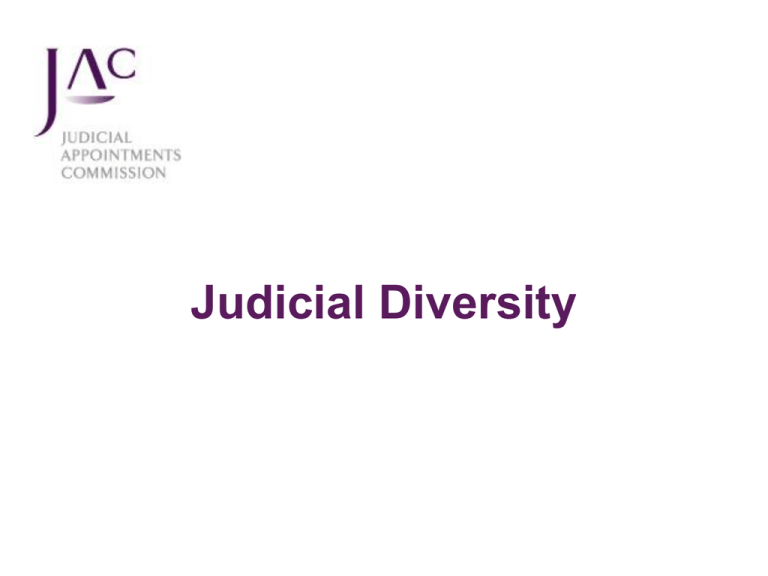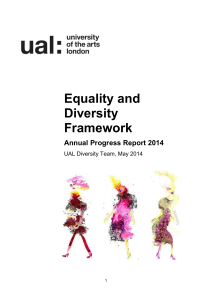jac_presentation. - Judicial Appointments Commission
advertisement

Judicial Diversity Constitutional Reform Act 2005 Aimed at: increasing independence of judiciary increasing diversity of appointments • Created Supreme Court independent of Parliament • Allowed for Lord Chancellor in Commons • Created independent JAC In 2005 there were: 3,800 FT and PT court judges 640 women (17%) 114 BAME (3%) JAC statutory duties – To select candidates solely on merit – To select only people of good character – To have regard to the need to encourage diversity in the range of persons available for selection for appointment Difficult birth – and sustained scrutiny 2007 Nooney Review - efficiency 2008 MoJ LEAN review - efficiency 2009 Neuberger Review - diversity 2010 End-to-End Review - organisation/management 2010/11 Public Bodies Bill: low point for JAC Scrutiny continued… 2011/12 MoJ Review - appointments system as a whole, with focus on diversity 2011/12 HoL Constitution Committee Review appointments system, including diversity New focus from then LC: - 2013 Cost - Speed - Diversity Crime and Courts Act – enhanced and extended role of JAC Crime and Courts Act 2013 • Equal merit provision • Increased lay membership and diversity of selection panels for senior appointments • Transferred chairmanship of panel to select LCJ and President UKSC to lay members of appointments bodies • Transferred responsibility for selecting deputy High Court judges to JAC • Statutory diversity duties for LCJ and LC JAC Diversity Strategy • Fair and non-discriminatory selection processes – now incorporating EMP • Advertising and Outreach – further targeted through candidate attraction project • Working with others to break down barriers – including via Diversity Forum Diverse staff: Diverse selection panels: Diverse Commission: Women 58% 64% 53% BAME 19% 8% 13% Selection process • Candidates submit competency-based application form • Short-listing by online test for larger exercises or paper sift for smaller/senior exercises • Selection day: interview and combination of: - presentation on subject specified by JAC; - role play exercise (usually for entry level posts); - situational questioning; - competence-based questions around the qualities and abilities required for the office. Performance of women candidates I • Applications from – and recommendations of women are higher under JAC • Proportion of applications is significantly higher for 6/7 posts, and recommendations significantly higher for 3/7 posts • Women making good progress at all levels of competition up to and including Court of Appeal: - 41% (1,668) of recommended candidates - 42% (1,173) of recommendations for legal roles - 35% (530) of recommendations for courts Performance of women candidates II • In last District Judge and Circuit Judge exercises, 54% (29/54) and 48% (26/54) of successful candidates were women • Women now make up 25% of courts judiciary – 830 of 3,282 judges – an increase of 8% (190) in nine years • Women make up 45% of tribunals judiciary 2,717 of 6,084 judges • Progress at most senior levels still slow Performance of BAME candidates I • Applications from – and recommendations of BAME candidates are higher under JAC • Proportion of applications from BAME candidates is significantly higher for 6/7 posts • BAME recommendations are significantly higher for one of the posts • BAME candidates have generally been recommended in line with level in eligible pool: - 10% (398) of recommended candidates - 7% (194) of recommendations for legal roles - 7% (105) of recommendations for court roles Performance of BAME candidates II • 6% of courts judiciary have BAME backgrounds – 157 of 3,282 judges – double 2005 proportion • 13% of tribunals judiciary are BAME – 740 of 6,054 judges • Progress at senior levels still slow Current and future challenges April 2014: Women BAME Total Judiciary 9,366 Courts only 3,282 38% (3,587) 10% (897) 25% (830) 5.8% (157) • Diversity of candidate pool an ongoing challenge • Need multiple routes in to the judiciary – and up • Impact of O’Brien and Miller litigation – reduction in fee-paid vacancies • Wider, ongoing financial constraints















